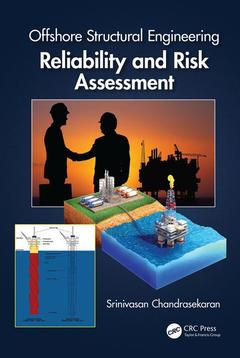Offshore Structural Engineering Reliability and Risk Assessment
Auteur : Chandrasekaran Srinivasan

Successfully estimate risk and reliability, and produce innovative, yet reliable designs using the approaches outlined in Offshore Structural Engineering: Reliability and Risk Assessment. A hands-on guide for practicing professionals, this book covers the reliability of offshore structures with an emphasis on the safety and reliability of offshore facilities during analysis, design, inspection, and planning.
Since risk assessment and reliability estimates are often based on probability, the author utilizes concepts of probability and statistical analysis to address the risks and uncertainties involved in design. He explains the concepts with clear illustrations and tutorials, provides a chapter on probability theory, and covers various stages of the process that include data collection, analysis, design and construction, and commissioning.
In addition, the author discusses advances in geometric structural forms for deep-water oil exploration, the rational treatment of uncertainties in structural engineering, and the safety and serviceability of civil engineering and other offshore structures.
An invaluable guide to innovative and reliable structural design, this book:
- Defines the structural reliability theory
- Explains the reliability analysis of structures
- Examines the reliability of offshore structures
- Describes the probabilistic distribution for important loading variables
- Includes methods of reliability analysis
- Addresses risk assessment and more
Offshore Structural Engineering: Reliability and Risk Assessment
CONCEPT OF PROBABILITY AND SAMPLING STATISTICS. STRUCTURAL RELIABILITY THEORY. RELIABILITY ANALYSIS. RISK ASSESSMENT. MODEL EXERCISE PAPERS. REFERENCES.
Srinivasan Chandrasekaran is a professor in the Department of Ocean Engineering, Indian Institute of Technology Madras, India. He has more than 25 years of teaching, research, and industrial experience. By invitation of the Ministry of Italian University Research, he was a visiting fellow to the University of Naples Federico II, Italy, for a period of two years. He has published approximately 140 research papers. He is a member of many national and international professional bodies and has delivered many invited lectures and keynote addresses at international conferences, workshops, and seminars organized in India and abroad.
Date de parution : 05-2016
15.6x23.4 cm
Disponible chez l'éditeur (délai d'approvisionnement : 15 jours).
Prix indicatif 142,05 €
Ajouter au panierThème d’Offshore Structural Engineering :
Mots-clés :
Sea Water; Limit State Function; risk analysis; Minimal Cut Set; quality assurance of structures; Tubular Joints; infrastructure health; Hot Spot Stress; Cut Set; Out-of Plane Bending; Stress Concentration Factor; Concept of Probability; Minimum Path Sets; Forward Uncertainty Propagation; Tether Tension; Bayesian Approach; HaZop Study; Rules of Probability; Failure Domain; Principles of Plausible Reasoning; Fatigue Damage; Deductive Logic; Cumulative Distribution Function; Deductive Reasoning; Stress Range; Continuous Probability; Limit State Surface; Urn Distribution; Hasofer Lind Reliability Index; Monte Carlo Simulation Method; Path Set; Directional Simulation; PSD Plot; Statistical Theories of Extremes; Standard Normal Space; Modeling of Environmental Loads; Fatigue Life Estimate; Structural Reliability Theory; Fault Tree; Probabilistic Approach; Punching Shear; First-Order Second Moment Method; Hasofer–Lind Method; Second-Order Reliability Methods; Simulation-Based Reliability Method; Reliability Estimate Using Higher-Order Response Surface Methods; High-Order Stochastic Response Surface Method; Reliability Analysis; Fundamental Analysis; Stochastic Modeling; Mechanical Modeling; Stochastic Process; Gaussian Process; S–N Curve; Cumulative Damage; Linear Damage Hypothesis; Discrete Wave Approach; Simplified Fatigue Assessment Method; Fatigue Analysis; Fatigue Reliability; Behavior of T Joints under Axial Loads; T Joint under out-of-Plane Bending; K Joints under Axial Loading; Hazard and Operability; Fault Tree Analysis; Event Tree Analysis; Cause–Consequence Analysis; Consequence Analysis; Individual Risk; Societal Risk; Offshore Triceratops



